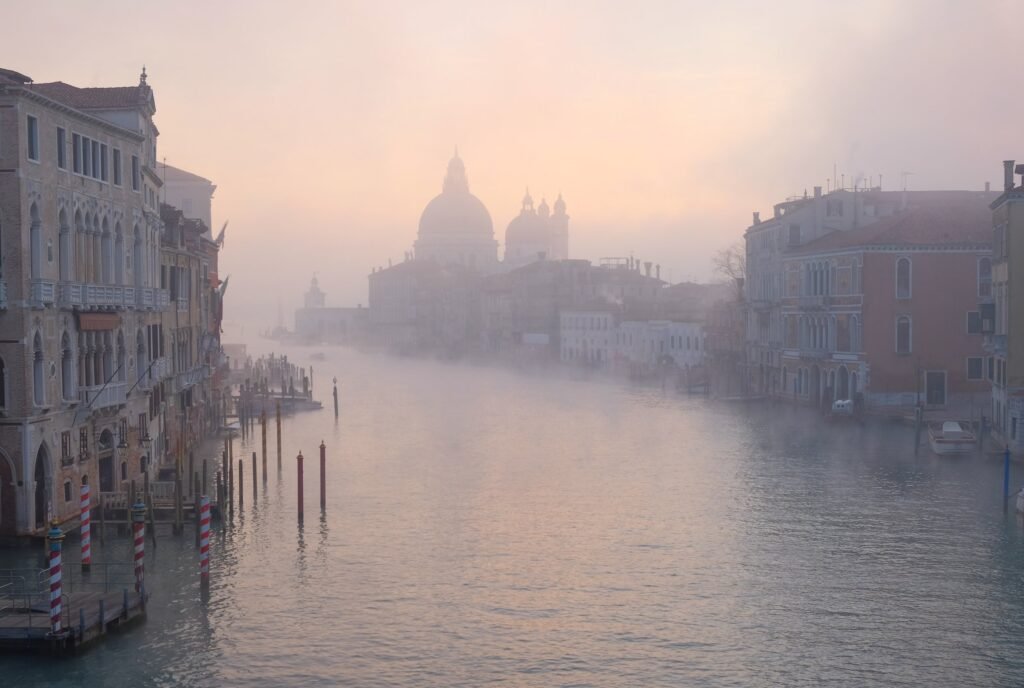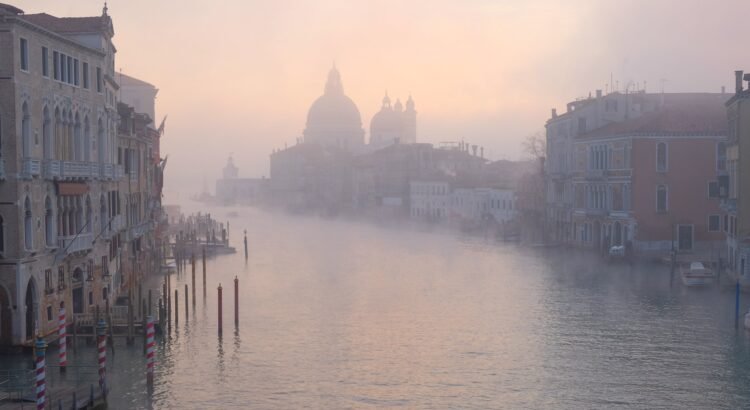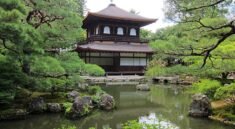
When one thinks of Venice, the mind often leaps to gondolas gliding down bustling canals, the grandeur of St. Mark’s Basilica, or the bright shimmer of Carnival masks sold in tourist stalls. But there is another Venice — one less photographed, more whispered about than seen. A Venice that stirs in the early morning mist, lingers in the echo of footsteps down narrow alleyways, and glows in the silence of a fog-draped lagoon.
This is the quieter, mystical Venice. A version of the city cloaked not in sunshine and selfie sticks, but in fog and forgotten stories. To discover it is to enter a realm where history blurs with legend, where shadows conceal secrets, and where every stone seems to whisper a tale from the past. It is here, in this hidden dimension of the city, that the soul of Venice is most clearly heard.
The Fog That Reveals
Contrary to what one might expect, it is not clarity that reveals the soul of Venice, but fog. In the early morning, before the crowds arrive, the city becomes a dreamscape — ghostly and quiet. Vaporetto boats slip soundlessly through the mist. Bridges emerge slowly from the haze. The outlines of buildings shimmer and recede, giving the impression that the entire city is floating, not just on water, but between worlds.
In winter and late autumn, when the Adriatic chill wraps around the lagoon, Venice dons a cloak of misty elegance. The fog softens every sound, muffling even the lapping of water. It sharpens your other senses — the texture of ancient stone beneath your fingertips, the salt in the air, the musty scent of time. This is the Venice that poets and painters fell in love with. This is the Venice of myths and melancholy.
Wandering Without Direction: Venice’s Labyrinth of Secrets
To fully experience this mystical side of Venice, you must allow yourself to get lost. Not metaphorically, but literally. The city’s maze of alleys, bridges, and hidden courtyards defies logic. Google Maps becomes useless. Street signs vanish into walls. But that’s the point.
In the misty quiet, you begin to notice things — an old carved face peeking from a wall, a moss-covered well in an empty campo, a forgotten chapel with a candle still burning inside. You hear your footsteps echo against the stones, and you begin to feel that you’re not just in a city, but in a living storybook, where each turn is another page, another mystery waiting to unfold.
The locals, wrapped in thick coats, walk quickly but quietly. There’s little rush. Venice has always existed at its own pace — a slow dance with time, unhurried, poetic, eternal.
Campi and Courtyards: Spaces of Stillness
While the main attractions are no doubt captivating, true Venetian magic lies in its campi (small squares) and courtyards. Tucked away from the beaten path, these hidden gems are where the city reveals its quieter soul.
In places like Campo San Giacomo dell’Orio or Campo Santa Margherita early in the day, you’ll find elderly Venetians sipping espresso, a few pigeons pecking the stone, and a silence that feels ancient. Some of these squares date back to the 10th century and were once vibrant centers of trade and religion. Today, they feel suspended in time — the beating heart of a city that refuses to forget its past.
Sometimes you’ll stumble upon a cloistered garden — overgrown, shadowed, quiet. The scent of damp earth and lemon trees mingles with the ever-present scent of the canals. These are the places where Venice hides its soul — not in grand gestures, but in hushed corners.
The Shadows of Legends: A City of Ghost Stories
Venice is as much a city of ghosts as it is of history. For every marble column and Byzantine arch, there is a tale attached — a tale of betrayal, love, vengeance, or redemption.
The fog is the perfect medium for these stories to rise from the stone. Local lore speaks of the ghost of Bianca, a woman who walks the streets of Castello at night searching for her lost lover, or the faceless monk seen wandering near the Arsenale where black ships once carried the secrets of the Republic.
There’s the legend of the cursed house in Cannaregio, where lights flicker mysteriously, and no owner stays for long. Or the execution bridge, Ponte dei Pugni, where once rival clans fought bare-fisted to throw their enemies into the canal below. The fog seems to carry these tales on its breath, making the line between reality and imagination beautifully unclear.
For those who dare, a nighttime walk through Venice’s mist-covered alleys is an unforgettable experience — one that feels more like stepping into a dream than taking a tour.
Churches of Silence and Splendor
While tourists flock to St. Mark’s Basilica or Santa Maria della Salute, it’s the lesser-known churches, veiled in fog and silence, that offer the richest spiritual encounters.
Step into San Zaccaria, and you’re met not just by gothic beauty, but by a hushed sanctity that lingers in the cool air. The church is home to a crypt partially submerged by water — an eerily beautiful reminder of Venice’s eternal conversation with the sea.
In San Pietro di Castello, once the city’s main cathedral, time seems to stand still. You might be the only person inside. Dust dances in the rays of light filtering through ancient glass. The silence is not empty but full — thick with prayer, with memory, with centuries of presence.
These are places that were not built just for grandeur, but for the soul — and in the fog, their meaning deepens.
A City of Reflection: Water As Mirror and Memory
Venice has no streets, only canals. Its pathways are rivers. Its mirrors are water. And in the fog, this relationship between the city and its reflection becomes surreal.
Buildings shimmer on the surface of the canals, appearing double — one real, one imagined. As gondolas glide silently through the mist, they seem to exist not in the present, but in some eternal space between past and now.
Sit beside the canal in the quiet hours of the morning, and you’ll begin to see why so many artists and writers were enchanted by Venice. The water holds the city’s stories. It remembers every whisper, every echo. It is at once a mirror, a memory, and a mystery.
Taste the Stillness: Food for the Soul
Even the culinary scene in mystical Venice changes when you step off the beaten track. Fog and silence make for more intimate dining. Osterie tucked into alleyways, with their flickering candles and wood-beamed ceilings, offer meals that feel like rituals.
Start with sarde in saor, sweet-and-sour sardines soaked in memory. Follow with risotto al nero di seppia, dyed black with squid ink, its color matching the city’s enigmatic mood. Pair it with a glass of Venetian Prosecco, not the sparkling party kind, but the soft, still version sipped slowly as mist clings to the windows.
The flavors here are not flashy — they are earthy, briny, poetic, born of sea and shadow.
Hidden Islands and Sacred Spaces
Beyond the main sestieri (districts), Venice’s lesser-known islands offer quiet sanctuaries for deeper reflection.
Take a boat to San Francesco del Deserto, a tiny island where Franciscan monks live in near silence. The fog here is heavier, holier. It wraps around the cypress trees, the crumbling walls, the footsteps of the monks who pray unseen. Visitors are welcome — not as tourists, but as pilgrims of peace.
Or visit Torcello, one of the oldest inhabited parts of the lagoon. Once more important than Venice itself, it now houses a handful of souls and the hauntingly beautiful Cathedral of Santa Maria Assunta, where Byzantine mosaics gleam like stars in the gloom.
These islands speak not loudly, but deeply — offering a retreat into silence, solitude, and the stories of centuries past.
Venice After Dark: When the City Breathes
As evening descends, and the fog thickens, the crowds retreat. The piazzas empty. Lights reflect like liquid gold on the canals. The city, so often overwhelmed by its own popularity, finally breathes.
Walk alone through San Polo, past shuttered shops and quiet churches. The silence is not lonely. It is rich, full of presence. The city becomes an opera in slow motion — every shadow a character, every corner a scene. No music plays, yet the atmosphere hums with emotion.
This is the moment when the mystical Venice, the soul-deep Venice, reveals itself fully. You are no longer a visitor. You are a part of its story.
Final Reflections: A Venice of the Spirit
The Venice beneath the fog is not found in guidebooks or package tours. It is a Venice that asks you to see with your heart, to hear with your memory, and to walk with reverence.
It is the city of artists, monks, ghosts, and lovers — of whispers and wonder. A city whose ancient stones are worn not just by time but by thought, by poetry, by dreams.
To discover this Venice is to learn that beauty need not be loud. That presence does not require noise. That a city built on water can float also on mystery, on spirit, and on stories untold.
So come to Venice. But come early, or late. Come when the fog is thick. Come when the silence is complete. And in that stillness, discover not just a city — but yourself.




